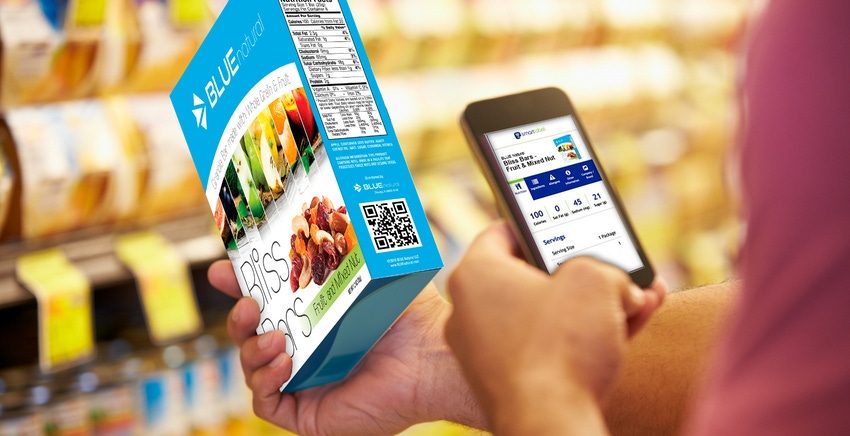February 12, 2018

The internet puts product information in the hands of shoppers. Is the SmartLabel the best way for brands to connect with consumers as they shop, either in-store or online? Consider the pros and cons.
Consumers’ shopping habits are rapidly shifting, and those changes are making waves for consumer packaged goods (CPG) companies. The always-accessible internet in the palms of our hands provided by mobile devices, tablets and other computers drives these changes. Consumers increasingly order groceries and CPG products online and use online information during offline in-store shopping. On top of that, federal regulations requiring all CPG companies to be compliant with requirements related to the nutrition panel take effect by 2018, and many companies will have thousands of products affected, across disparate markets, product lines, channels and product variations.
To address these changes, many companies are turning to the SmartLabel, an initiative championed by the Grocery Manufacturer’s Assn. (GMA) to provide more transparency to consumers via web pages accessed through a search, quick-response (QR) code, app or retailers’ customer service desks. As with most new technologies and initiatives, however, there are pros and cons to SmartLabel. Let’s take a look at them.
SmartLabel Pros
The top benefit, of course, is that consumers seeking information on allergens, calories, ingredients and even the use of genetically modified organisms (GMOs) have everything they need at the scan of a QR code. This enables them to make quick, yet confident decisions about which products to purchase.
For CPG companies, while there will be some required items to include on SmartLabel landing pages, for the most part, they still control what appears on each of the five designated website tabs. This helps ensure information is delivered to the consumer in a brand-friendly way.
Finally, the SmartLabel provides companies with a reliable and informative online presence, which is important for reaching the modern omni-channel consumer who shops both in-store and online. While it’s unlikely that SmartLabel landing pages will be the only web presence for a product, it’s still a reliable source of information for consumers provided in a standardized format, and big companies including Unilever have embraced them as part of their transparency initiatives.
SmartLabel Cons
While the SmartLabel provides consumers with what they want (transparency), most CPG manufacturers would prefer a dialogue with consumers, in which consumers come to them to discuss the product. The idea of a standardized SmartLabel doesn’t thrill some CPG companies today for a number of different reasons including:
• Making so much information available accurately and quickly can be a huge undertaking.
• CPG companies work hard to differentiate products through branding; standardized reporting of ingredients across a category may not offer the same opportunity to differentiate.
• While some brands want to shine a spotlight on their ingredients list, others would rather not.
• Many retailers want—and some are demanding—manufacturers to turn over all of their product information, – even drawings and specs, to enable them to build the best possible shopping experience; manufacturers are wrestling with the question: how much is enough?
A balancing act
There’s no getting around the changing federal regulations, but the SmartLabel movement isn’t mandatory. So how should CPG companies determine whether to join up and decide how much information they should share?
For most, it’s a balancing act. With changing consumer habits, it’s important to have an easily accessible online presence to sway consumers in their purchasing decisions. At the same time, providing too much information can distract from the preferred interactions/conversations brands would prefer.
These are the questions companies, specifically many marketing teams who have become responsible for the consumer experience, must answer. For many, changing federal regulations may be the impetus for companies to adopt the SmartLabel since a new load of information must be made available for consumer transparency anyway.
By carefully weighing the pros and cons of SmartLabel, CPG companies can begin to determine whether easily accessible product landing pages can be a boon to sales, as well as exactly what information should be included—beyond federal mandate—to ensure everything remains brand compliant.
Of course, for companies who decide to jump into the SmartLabel game, label and artwork management (LAM) technologies can help ease the burden by simplifying asset management, design and approval processes across all affected stock-keeping units (SKUs). CPG companies of all shapes and sizes can turn to these automated tools or leverage those they already use for a competitive advantage today or to catch up with competitors tomorrow. As the software as a service (SaaS) model emerges with this type of technology, many smaller manufacturers now have access to many of the same tools as their behemoth competitors.

Stephen Kaufman is the chief product officer for BLUE Software, a label and artwork management technology provider that serves 12,000 brands across 5,000 companies worldwide. Reach him at [email protected].
About the Author(s)
You May Also Like




